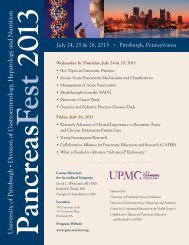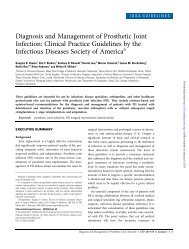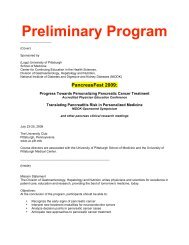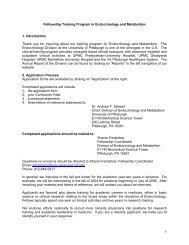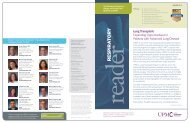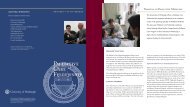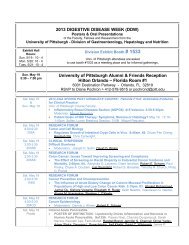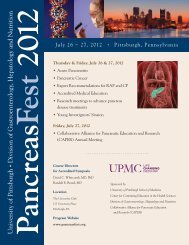2009 DOM Annual Report - Department of Medicine - University of ...
2009 DOM Annual Report - Department of Medicine - University of ...
2009 DOM Annual Report - Department of Medicine - University of ...
- No tags were found...
Create successful ePaper yourself
Turn your PDF publications into a flip-book with our unique Google optimized e-Paper software.
<strong>Department</strong> <strong>of</strong> <strong>Medicine</strong>HIGH IMPACT PUBLICATIONSDr. Ridgway and colleagues (Diabetes 56:186-196, 2007) demonstrated that treatment <strong>of</strong> nonobese diabetic (NOD) mice, an animal model <strong>of</strong>spontaneous Type one diabetes (T1D), with an agonist anti-CD137 antibody prevented diabetes. The mechanism <strong>of</strong> protection was specificallymediated by CD4+CD25+CD137+ T regulatory cells. This research is important because candidate genes in NOD diabetes have <strong>of</strong>ten been foundin human diabetes.Dr. Ascherman and colleagues (Journal <strong>of</strong> Autoimmunity 29:174-186, 2007) continue to study the role <strong>of</strong> Jo-1 directed B and T cell responsesin different genetic backgrounds <strong>of</strong> animal models (C57BL/6 and NOD congenic mice). This animal model <strong>of</strong> myositis provides a uniqueopportunity for elucidating the mechanisms <strong>of</strong> this immune-mediated muscle disease.Dr. Wasko and colleagues (JAMA 298:187-193, 2007) reported from a study evaluating patients with rheumatoid arthritis the role <strong>of</strong>hydroxychloroquine in preventing or reducing the risk <strong>of</strong> diabetes. These finding provide the framework for defining additional mechanisms <strong>of</strong>action <strong>of</strong> this commonly used arthritis medication.A major research focus in the Lupus Center <strong>of</strong> Excellence is the dramatic 50-fold increased risk <strong>of</strong> myocardial infarction observed in youngwomen with lupus. Research progress in this field has been hampered by the lack <strong>of</strong> an informative animal model that can be used tounderstand the mechanisms <strong>of</strong> this process and to develop effective therapies. Investigators in the Lupus Center <strong>of</strong> Excellence, in collaborationwith the McGowan Institute for Regenerative <strong>Medicine</strong>, the Center for Vascular Remodeling and Regeneration, and the <strong>Department</strong> <strong>of</strong>Bioengineering have recently reported successful development <strong>of</strong> the first experimental model for ex vivo investigation <strong>of</strong> vascular stiffness andatherosclerosis in a mouse model. This multidisciplinary team, using a laser-based perfusion system, successfully measured the progression<strong>of</strong> vascular stiffness, an early sign <strong>of</strong> atherosclerosis, in the aortas <strong>of</strong> mice deficient in apolipoprotein E. Additional studies, performed incollaboration with the Center for Biologic Imaging, simultaneously identified pathologic inflammatory and immune responses within the vesselwall during progression <strong>of</strong> the disease. These advances can now be extended to investigate atherosclerosis in mouse models <strong>of</strong> lupus and otherhuman vascular disorders and to identify potential targets for therapeutic intervention in humans.SELECTED SCHOLARLY ACTIVITIESStudy sections (excluding ad hoc review), editorial boards, and other honorsGrant ReviewJoseph M. Ahearn NIH NIAMS Special Emphasis Panel, Chair: ZAR MLB-L 01 (K awards), 2006, Dept. <strong>of</strong> Veterans Affairs - Merit Review Board forImmunology, Wellcome Trust Scientific Reviewer, Lupus Panel; <strong>Department</strong> <strong>of</strong> Defense; Scientific Peer Advisory and Review NHLBI Study Section,Member, 200758 Better medicine through research and education.




